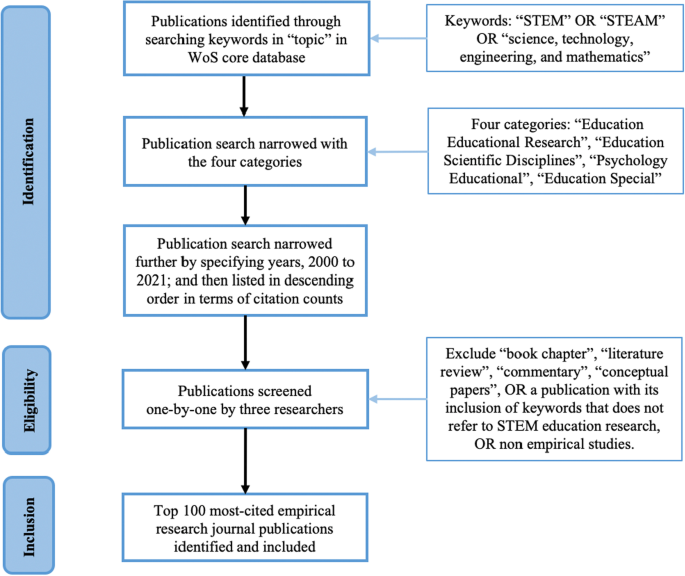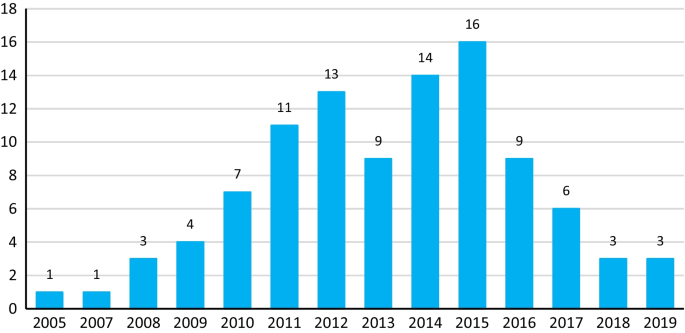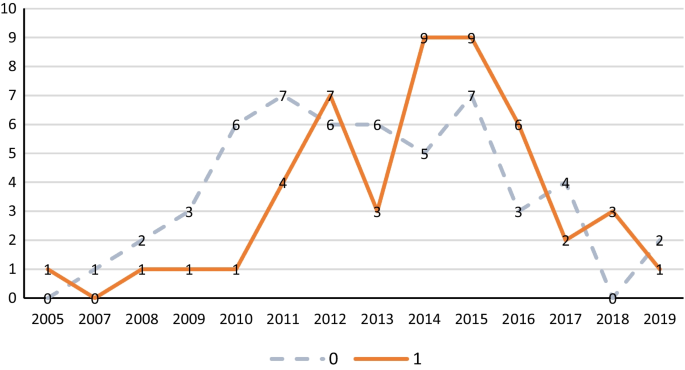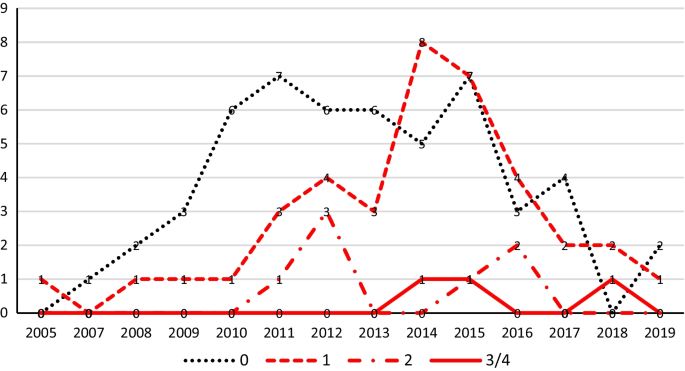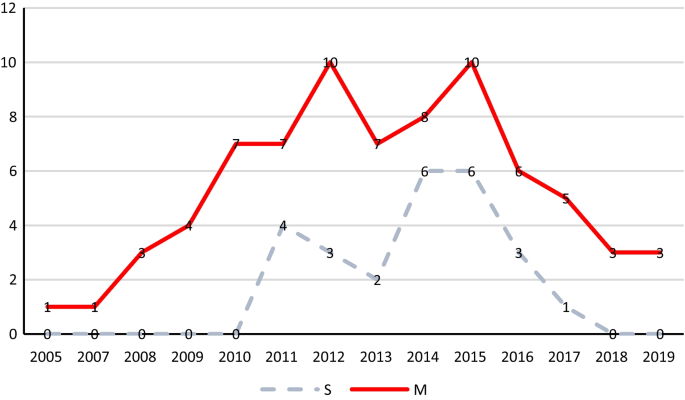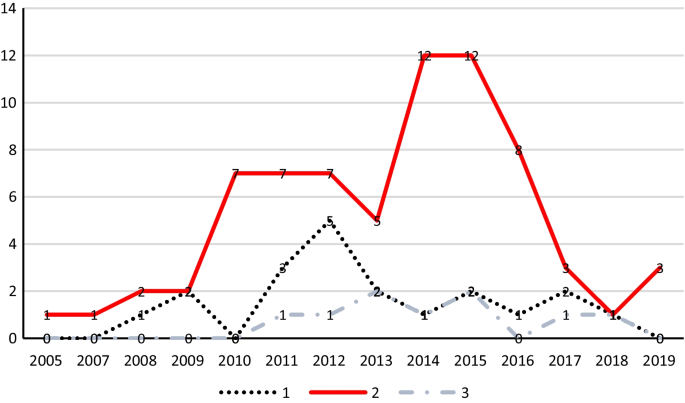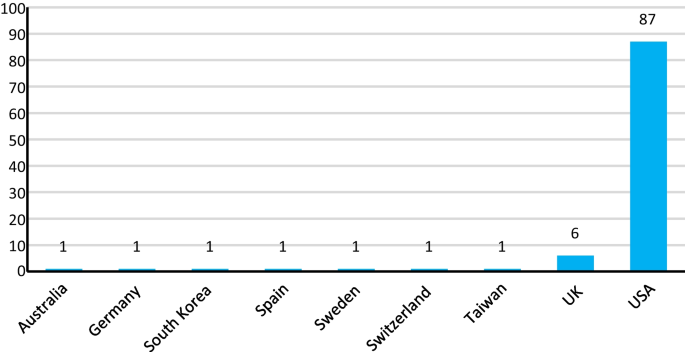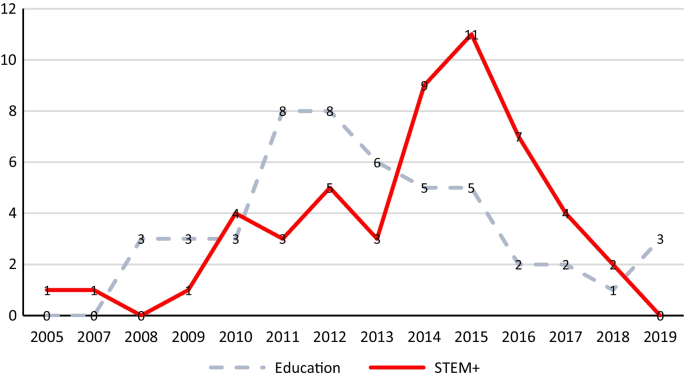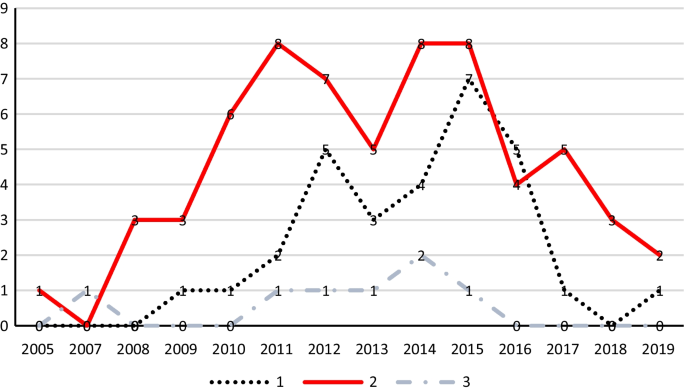- Editorial
- Open access
- Published:
A systematic review of high impact empirical studies in STEM education
International Journal of STEM Education volume 9, Article number: 72 (2022)
Abstract
The formation of an academic field is evidenced by many factors, including the growth of relevant research articles and the increasing impact of highly cited publications. Building upon recent scoping reviews of journal publications in STEM education, this study aimed to provide a systematic review of high impact empirical studies in STEM education to gain insights into the development of STEM education research paradigms. Through a search of the Web of Science core database, we identified the top 100 most-cited empirical studies focusing on STEM education that were published in journals from 2000 to 2021 and examined them in terms of various aspects, including the journals where they were published, disciplinary content coverage, research topics and methods, and authorship’s nationality/region and profession. The results show that STEM education continues to gain more exposure and varied disciplinary content with an increasing number of high impact empirical studies published in journals in various STEM disciplines. High impact research articles were mainly authored by researchers in the West, especially the United States, and indicate possible “hot” topics within the broader field of STEM education. Our analysis also revealed the increased participation and contributions from researchers in diverse fields who are working to formulate research agendas in STEM education and the nature of STEM education scholarship.
Introduction
Two recent reviews of research publications, the first examining articles in the International Journal of STEM Education (IJSTEM) and the second looking at an expanded scope of 36 journals, examined how scholarship in science, technology, engineering, and mathematics (STEM) education has developed over the years (Li et al., 2019, 2020a). Although these two reviews differed in multiple ways (e.g., the number of journals covered, the time period of article publications, and article selection), they shared the common purpose of providing an overview of the status and trends in STEM education research. The selection of journal publications in these two reviews thus emphasized the coverage and inclusion of all relevant publications but did not consider publication impact. Given that the development of a vibrant field depends not only on the number of research outputs and its growth over the years but also the existence and influence of some high impact research articles, here we aimed to identify and examine those high impact research publications in STEM education in this review.
Learning from existing reviews of STEM education research
Existing reviews of STEM education have provided valuable insights about STEM education scholarship development over the years. In addition to the two reviews mentioned above, there are many other research reviews on different aspects of STEM education. For example, Chomphuphra et al. (2019) reviewed 56 journal articles published from 2007 to 2017 covering three popular topics: innovation for STEM learning, professional development, and gender gap and career in STEM. They identified and selected these journal articles through searching the Scopus database and two additional journals in STEM education that were not indexed in Scopus at that time. Several other reviews have been conducted and published with a focus on specific topics, such as the assessment of the learning assistant model (Barrasso & Spilios, 2021), STEM education in early childhood (Wan et al., 2021), and research on individuals' STEM identity (Simpson & Bouhafa, 2020). All of these reviews helped in summarizing and synthesizing what we can learn from research on different topics related to STEM education.
Given the on-going rapid expansion of interest in STEM education, the number of research reviews in STEM education research has also been growing rapidly over the years. For example, there were only one or two research reviews published yearly in IJSTEM just a few years ago (Li, 2019). However, the situation started to change quickly over the past several years (Li & Xiao, 2022). Table 1 provides a summary list of research reviews published in IJSTEM in 2020 and 2021. The journal published a total of five research reviews in 2020 (8%, out of 59 publications), which then increased to seven in 2021 (12%, out of 59 publications).
Taking a closer look at these research reviews, we noticed that three reviews were conducted with a broad perspective to examine research and trends in STEM education (Li et al., 2020a, 2020b) or STEAM (science, technology, engineering, arts, and mathematics) education (Marin-Marin et al., 2021). Relatively large numbers of publications/projects were reviewed in these studies to provide a general overview of research development and trends. The other nine reviews focused on research on specific topics or aspects in STEM education. These results suggest that, with the availability of a rapidly accumulating number of studies in STEM education, researchers have started to go beyond general research trends to examine and summarize research development on specific topics. Moreover, across these 12 reviews, researchers used many different approaches to search multiple data sources (often with specified search terms) to identify and select articles, including journal publications, research reports, conference papers, or dissertations. It appears that researchers have been creative in developing and using specific approaches to select and review publications that are pertinent to their topics. At the same time, however, none of these reviews were designed and conducted to identify and review high impact research articles that had notable influences on the development of STEM education scholarship.
The importance of examining high impact empirical research publications in STEM education
STEM education differs from many other fields, as STEM itself is not a discipline. There are diverse perspectives about the disciplinarity of STEM and STEM education (e.g., Erduran, 2020; Li et al., 2020a; Takeuchi et al., 2020; Tytler, 2020). The complexity and ambiguity in viewing and examining STEM and STEM education presents challenges as well as opportunities for researchers to explore and specify what and how they do in ways different from and/or connected with traditional education in the individual disciplines of science, technology, engineering, and mathematics.
Although the field of STEM education is still in an early stage of its development, STEM education has experienced tremendous growth over the past decade. This field has evolved from traditional individual discipline-based education in STEM fields to multi- and interdisciplinary education in STEM. The development of STEM education has been supported by multiple factors, including research funding (Li et al., 2020b) and the growth of research publications (Li et al., 2020a). High impact publications play a very large role in the growth of the field, as they are read and cited frequently by others and serve to shape the development of scholarship in the field more than other publications.
Among high impact research publications, we can identify several different types of articles, including empirical studies, research reviews, and conceptual or theoretical papers. Research reviews and conceptual/theoretical papers are very valuable, as they synthesize existing research on a specific topic and/or provide new perspective(s) and direction(s), but they are typically not empirical studies. Review articles aim to provide a summary of the current state of the research in the field or on a particular topic, and they help readers to gain an overview about a topic, key issues and publications. Thus, they are more about what has been published in the literature about a topic and less about reporting new empirical evidence about a topic. Similarly, theoretical or conceptual papers tend to draw on existing research to advance theory or propose new perspectives. In contrast, empirical studies require the use and analysis of empirical data to provide empirical evidence. While reporting original research has been typical in empirical studies in education, these studies can also be secondary analyses of empirical data that test hypotheses not considered or addressed in previous studies. Empirical studies are generally published in academic, peer-reviewed journals and consist of distinct sections that reflect the stages in the research process. With the aim to gain insights about research development in STEM education, we thus decided to focus here on empirical studies in STEM education. Examining and reviewing high impact empirical research publications can help provide us a better understanding about emerging trends in STEM education in terms of research topics, methods, and possible directions in the future.
Considerations in identifying and selecting high impact empirical research publications
Publishing as a way of disseminating and sharing knowledge has many types of outlets, including journals, books, and conference proceedings. Different publishing outlets have different advantages in reaching out to readers. Researchers may search different data sources to identify and select publications to review, as indicated in Table 1. At the same time, journal publications are commonly chosen and viewed as one of the most important outlets valued by the research community for knowledge dissemination and exchange. Specifically, there are two important advantages in terms of evaluating the quality and impact of journal publications over other formats. First, journal publications typically go through a rigorous peer-review process to ensure the quality of manuscripts for publication acceptance based on certain criteria. In educational research, some common criteria being used include “Standards for Reporting on Empirical Social Science Research in AERA Publications” (AERA, 2006), “Standards for Reporting on Humanities-Oriented Research in AERA Publications” (AERA, 2009), and “Scientific Research in Education” (NRC, 2002). Although the peer-review process is also employed in assessing and selecting proposals or papers for publication acceptance in other formats such as books and conference proceedings, the peer-review process employed by journals (esp. those reputable and top journals in a field) tends to be more rigorous and selective than other publication formats. Second, the impact of journals and their publications has frequently been evaluated by peers and different indexing services for inclusion, such as Clarivate’s Social Sciences Citation Index (SSCI) and Elsevier’s Scopus. The citation information collected and evaluated by indexing services provides another important measure about the quality and impact of selected journals and their publications. Based on these considerations, we decided to select and review those journal publications that can be identified as having high citations to gain an overview of their impact on the research development of STEM education.
Focusing on the selection and review of journal publications with high citations has also been used by many other scholars. For example, Martín‐Páez et al. (2019) conducted a literature review to examine how STEM education is conceptualized, used, and implemented in educational studies. To ensure the quality of published articles for review, they searched and selected journal articles published in the 2013–2018 period from the Web of Science (WoS) database only. Likewise, Akçayır and Akçayır (2017) conducted a systematic literature review on augmented reality used in educational settings. They used keywords to search all SSCI-indexed journals from WoS database to identify and select published articles, given that WoS provides easy access to search SSCI indexed articles. In addition to the method of searching the WoS database, some researchers used other approaches to identify and select published articles with high citations. For example, some researchers may search different databases to identify and select articles for reviews, such as Scopus (Chomphuphra et al., 2019) and Google (Godin et al., 2015). In comparison, however, the WoS core database is more selective than many others, including Scopus. The WoS is the world’s leading scientific citation search and analytical information platform (Li et al., 2018), and has its own independent and thorough editorial process to ensure journal quality together with the most comprehensive and complete citation network (https://clarivate.com/webofsciencegroup/solutions/webofscience-ssci/). Its core database has been commonly used as a reliable indexing database with close attention to high standard research publications with a peer-review process and is thus used in many research review studies (e.g., Akçayır & Akçayır, 2017; Li et al., 2018; Marín-Marín et al., 2021; Martín‐Páez et al., 2019).
It should be noted that some researchers have used a different approach to identify and select high impact publications other than focusing on article citations. This alternative approach is to identify leading journals from specific fields first and then select relevant articles from these journals. For example, Brown (2012) identified and selected eight important journals in each STEM discipline after consulting with university faculty and K-12 teachers. Once these journals were selected, Brown then located 60 articles that authors self-identified as connected to STEM education from over 1100 articles published between January 1, 2007 and October 1, 2010. However, as there was no well-established journal in STEM education until just a few years ago (Li et al., 2020a), the approach used by Brown may be less useful for identifying high impact publications in the field of STEM education. In fact, researchers in STEM education have been publishing their high-quality articles in many different journals, especially those well-established journals with an impact factor. Thus, this approach will not help ensure the selection of high impact articles in STEM education, even though they were selected from well-recognized journals rooted in each of STEM disciplines.
In summary, we searched the WoS core database to identify and select high impact empirical research articles in STEM education as those highly cited articles published in journals indexed and collected in the WoS.
Current review
Similar to previous research reviews (e.g., Li et al., 2020a), we need to specify the scope of the current review with specific considerations of the following two issues:
-
1.
What time period should be considered?
-
2.
How should we identify and select highly cited research publications in STEM education?
Time period
As discussed in a previous review (Li et al., 2020a), the acronym STEM did not exist until the early 2000s. The existence of the acronym has helped to focus attention on and efforts in STEM education. Thus, consistent with the determination of the time period used in the previous review on examining the status and trends in STEM education, we decided to select articles starting from the year 2000. At the same time, we can use the acronym of STEM as an identifier in locating journal articles in a way as done before (Li et al., 2020a) and also by others (e.g., Brown, 2012; Mizell & Brown, 2016). We chose the end of 2021 as the end of the time period for publication search and inclusion.
Searching and identifying highly cited empirical research journal publications in STEM education
To identify and select journal articles in STEM education from the WoS core database, we decided to use the common approach of keyword searches as used in many other reviews (e.g., Gladstone & Cimpian, 2021; Winterer et al., 2020). Li et al. (2020a) also noted the complexity and ambiguity of identifying publications in STEM education. Thus, we planned to identify and select publications in STEM education as those self-identified by authors. As mentioned above, we then used the acronym STEM (or STEAM) as key terms in our search for publications in STEM education.
Different from the previous review on research status and trends in STEM education (Li et al., 2020a), the current review aimed to identify and select high impact journal articles but not coverage. Thus, we decided to define and limit the scope of high impact empirical research journal publications as the top 100 most-cited empirical research journal publications obtained from the WoS core database.
Research questions
Li et al. (2020a) showed that STEM education articles have been published in many different journals, especially with the limited journal choices available in STEM education. Given a broader range of journals and a longer period of time to be covered in this review, we can thus gain some insights through examining multiple aspects of the top 100 most-cited empirical studies, including journals in which these empirical studies were published, publication years, disciplinary content coverage, research topics and methods. In addition, recent reviews suggested the value of examining possible trends in the authorship and school level focus (Li, 2022; Li & Xiao, 2022). Taken together, we are interested in addressing the following six research questions:
-
1.
What are the top 100 most-cited empirical STEM education research journal publications?
-
2.
What are the distributions and patterns of the top 100 most-cited empirical research publications in different journals?
-
3.
What is the disciplinary content coverage of the top 100 most-cited empirical research journal publications and possible trends?
-
4.
What are research topics and methods of the top 100 most-cited empirical research journal publications?
-
5.
What are the corresponding authors’ nationalities/regions and professions?
-
6.
What are school level foci of the top 100 most-cited empirical research journal publications over the years?
Methods
Based on the above discussion, we carried out the following steps for this systematic review to address these research questions.
Searching and identifying the top 100 most-cited empirical research journal publications in STEM education
Figure 1 provides a summary of the article search and selection process that was used for this review. The process started with a search of the WoS core database on September 12, 2022 under the field of “topic” (covering title, abstract, author keywords, and keywords plus), using the search terms: “STEM” OR “STEAM” OR “science, technology, engineering, and mathematics”. Because there are many different categories in the WoS database, we then specified the publication search using the four WoS categories listed under “education”: “Education Educational Research,” “Education Scientific Disciplines,” “Psychology Educational,” and “Education Special.” The time period of publication search was further specified as starting from 2000 to 2021.
The search returned 9275 publications under “Education Educational Research,” 2161 under “Education Scientific Disciplines,” 247 under “Psychology Educational,” and 15 under “Education Special.” The combined list of all publications was then placed in descending order in terms of citation counts up to the search date of Sept. 12, 2022, and each publication record was screened one-by-one by three researchers using the inclusion or exclusion criteria (see Table 2). At times when the publication record listed was not detailed enough, we searched and obtained the full article to screen and check to determine its eligibility. The process ended after identifying and selecting the top 100 most-cited empirical research journal publications.
Data analysis
To address research question 3, we categorized all 100 publications in terms of the number of STEM disciplines covered in a study. Two general categories were used for this review: publications within a single discipline of STEM vs. those with multi- or inter-disciplines of STEM. In contrast to the detailed classifications used in a previous review (Li et al., 2020a), this simplified classification can help reveal overall trends in disciplinary content coverage and approach reflected in high impact empirical research in STEM education.
To examine research topics, we used the same list of topics from previous reviews (Li & Xiao, 2022; Li et al., 2020a). The following list contains the seven topic categories (TCs) that were used to classify and examine all 100 publications identified and selected from the search in this study.
TC1: Teaching, teacher, and teacher education in STEM (including both pre-service and in-service teacher education) in K-12 education;
TC2: Teacher and teaching in STEM (including faculty development, etc.) at post-secondary level;
TC3: STEM learner, learning, and learning environment in K-12 education;
TC4: STEM learner, learning, and learning environments (excluding pre-service teacher education) at post-secondary level;
TC5: Policy, curriculum, evaluation, and assessment in STEM (including literature reviews about a field in general);
TC6: Culture, social, and gender issues in STEM education;
TC7: History, epistemology, and perspectives about STEM and STEM education.
To examine research methods, we coded all publications in terms of the following methodological categories: (1) qualitative methods, (2) quantitative methods, and (3) mixed methods. We assigned each publication to only one research topic and one method, following the process used in the previous reviews (Li et al., 2019, 2020a). When there was more than one topic or method that could have been used for a publication, a final decision was made in choosing and assigning the primary topic and/or method after discussion.
To address research question 5, we examined the corresponding author’s (or the first author, if no specific indication was given about the corresponding author) nationality/region and profession. Many publications in STEM education have joint authorship but may contain limited information about different co-authors. Focusing on the corresponding author’s nationality/region is a feasible approach as we learned from a previous research review (Li et al., 2020a). For the corresponding author’s profession, we used the same two general categories from the recent reviews (Li, 2022; Li & Xiao, 2022): “education” and “STEM+” that differentiate a corresponding author’s profession in education/educational research vs. disciplines and fields other than education. If a publication’s corresponding author was listed as affiliated with multiple departments/institutions, the first department/institution affiliation was chosen and used to identify the author’s nationality/region and profession.
To answer research question 6, we adopted the three categories from recent research reviews: K-12, postsecondary, and general (Li, 2022; Li & Xiao, 2022). The use of these school level categories helped reveal the distribution of STEM education research interests and development over the school level span. While the first two categories are self-explanatory, the “general” category is for those empirical research publications on questions or issues either pertinent to all school levels or that cross the boundary of K-12 school and college.
Results and discussion
The following sections are structured to report findings as corresponding to each of the six research questions.
Top 100 most-cited empirical research articles from 2000 to 2021
Figure 2 shows the distribution of the top 100 most-cited empirical research journal publications in STEM education over the years 2000–2021. As the majority of these publications (72 out of 100, 72%) were published between 2011 and 2016, the results suggest that publications typically need about 5–10 years to accumulate high enough citations for inclusion. Research articles published more than 10 years ago would likely become out-of-dated, unless those studies have been recognized as classic in the field. Some recent publications (6 publications, 2018–2019) emerged with high citations could suggest the emergency of interesting ‘hot’ topics in the field.
To have a more fine-grained sense of these highly cited research articles, we took a more detailed look at the top ten most-cited publications from the search (see Table 3). These ten most-cited publications were published between 2005 and 2014, with an average of 337 citations and a range of 238–820 citations per article. Only two of the top ten articles were published before 2010; both gained very impressive citations over the years (820 citations for the article published in 2009 and 289 citations for the other published in 2005). The on-going high citations of these two research articles are clear indication of their impact and importance in the field.
Table 3 also shows that the top ten list of most-cited empirical research articles were published in six different journals, with the majority of these journals focusing on general educational research or educational psychology. The importance of STEM education research was clearly recognized with high impact publications in these well-established journals. At the same time, the results imply the rapid development of STEM education research in its early stages and the value of examining possible trends in journals that published high impact articles in STEM education over time.
Moreover, we noticed that all of these top ten articles had corresponding authors who were from the U.S., with the exception of one by researchers in the U.K. This result is consistent with what we learned from previous reviews of STEM education research publications (Li et al., 2019, 2020a). About 75% of STEM-related journal publications were typically contributed by U.S. scholars, either in this journal’s publications from 2014 to 2018 (Li et al., 2019) or publications from 36 journals from 2000 to 2018 (Li et al., 2020a). It is not surprising that all of these high impact research publications from 2005 to 2014 were contributed by researchers in the West, especially the United States. (Below we report more about the corresponding authorship of the 100 high impact research publications beyond the top 10 that are reported here.)
Distributions and patterns of highly cited publications across different journals
Forty-five journals were identified as publishing these top 100 most-cited articles. Table 4 shows that the majority (26) of these journals focus on general educational research or educational psychology, publishing 52 of the top 100 most-cited articles. Fourteen journals with titles specifying a single discipline of STEM published 38 of these top 100 articles, three journals with two specified STEM disciplines in their titles published seven of these articles, one journal with three specified STEM disciplines published one article, and one journal specifying all four STEM disciplines published two articles. Among these 45 journals, 36 journals are indexed in SSCI, with the remaining nine journals indexed in ESCI (Emerging Sources Citation Index). These are clearly all reputable and well-established journals, with 36 established before 2000 and 9 established in or after 2000. Only three journals in the list are Open Access (OA) journals, and they were all established after 2000. The results suggest that researchers have been publishing high impact STEM education research articles in a wide range of well-established traditional journals, with the majority in general educational research or educational psychology with a long publishing history. It further confirms that the importance of STEM education research has been well-recognized in educational research or educational psychology as noted above. At the same time, the results imply that the history of STEM education itself has been too brief to establish its own top journals and identity except only one in STEM education (IJSTEM) (Li et al., 2020a).
Among these 45 journals listed in Table 4, we classified them into two general categories: general education research journals (26, all without mention of a discipline of STEM in a journal’s title) and those (19) with one or more STEM disciplines specified in a journal’s title. Figure 3 presents the distributions of these top 100 articles in these two general categories over the years. Among 49 articles published before 2014, the majority (31, 63%) of these articles were published in journals on general educational research or educational psychology. However, starting in 2014, a new trend emerged with more of these highly cited articles (30 out of 51, 59%) published in journals with STEM discipline(s) specified. The result suggests a possible shift of developing and gaining disciplinary content consciousness in STEM education research publications.
As a further examination of the distribution of publications in journals specified with STEM discipline(s), Fig. 4 shows the distributions of these highly cited articles in different journal categories over the years. It is clear that these highly cited articles were typically published in journals on general educational research or educational psychology before 2014. However, things started to change since 2014, with these highly cited articles published in more diverse journals including those with STEM discipline(s) specified in the journal titles. The journals that include only a single discipline of STEM have been more popular than others among those journals that specify one or more STEM disciplines. The result is not surprising as journals specified with a single discipline of STEM are more common, often with a long publishing history and support from well-established professional societies of education on a single discipline of STEM. This trend suggests that the importance of STEM education has also gained increasing recognition from professional societies that used to focus on a single discipline of STEM.
Distribution of highly cited research articles across different journal categories over the years. (Note: 0 = journals without STEM discipline specified, 1 = journals with a single discipline of STEM specified, 2 = journals with two disciplines of STEM specified, 3/4 = journals with 3 or 4 disciplines of STEM specified.)
To glimpse into those recent changes, we took a closer look at the six articles published in 2018 and 2019 as examples (see Table 5). All of these articles have been highly cited in just 3 or 4 years, with an average of 102 citations (range, 75–144) per article. Across these six articles, the majority were published in journals whose titles specified one or more STEM disciplines: three in journals with a single discipline of STEM specified, one in a journal on STEM education, and two in journals on general educational research. At the same time, these recent publications are not specifically on any single discipline of STEM, but multi- and interdisciplinary STEM education.
Disciplinary content coverage
The search of STEM education publications from the WoS core database relied on several keywords that the authors used to self-identify their research on STEM education. After coding and categorizing all top 100 publications, 25 research publications were found as focusing on a single discipline of STEM and 75 publications on multi- and interdisciplinary STEM education. The majority of these 100 most-cited empirical studies, in their focus on multi- and interdisciplinary STEM education, reflects the overall focus in STEM education, a trend consistent with what was learned from a previous review of journal publications in STEM education (Li et al., 2020a).
Among the 25 research articles on a single discipline of STEM, the majority of these articles (56%, 14 out of 25) focused on science, 5 articles on technology, 4 articles on mathematics, and 2 articles on engineering. The result suggests that of the four STEM disciplines, arguably “science” is the broadest category and so it is not surprising that the number of publications on science is the most prevalent. Indeed, the result is also consistent with what we can learn from Table 4. Among the 14 journals specifying a single STEM discipline that published 38 of the top 100 articles, seven journals focus on “science” that published 27 of these 38 articles.
To examine possible trends over time, Fig. 5 shows the distribution of these 100 articles across these two disciplinary content coverage categories over the years. For each of the publishing years from 2005 to 2019, there were always more high citation empirical publications on multi- and interdisciplinary STEM education than high citation publications focusing on a single discipline of STEM. Moreover, there were no high citation publications on a single discipline of STEM before 2011 or after 2017 that made the cut for inclusion in the top 100 list. These results suggest an overall trend of on-going emphasis on multi- and interdisciplinary research in STEM education, which can be further verified by what we learned from the six recent publications in Table 5.
Research topics and methods
Table 6 presents the distribution of all 100 highly cited publications classified in terms of the seven topic categories (TCs) over the years. Overall, all seven TCs have publications that were on the top 100 high citation publication list. There were clearly the most publications on TC6 (culture, social, and gender issues in STEM education), followed by publications on TC4 (STEM learner, learning, and learning environments at post-secondary level). The large number of publications with high citations in these two categories suggest possible evolution of research interests and topics in the field of STEM education. Taking a closer look at the six recent publications in Table 5, it is clear that culture, social, and gender issues were the focus in these recent publications, with the exception of one publication on assessment. This result presents a picture that appears somewhat different from what we learned from previous research reviews that did not focus exclusively on high impact publications from the WoS database (Li & Xiao, 2022; Li et al., 2020a).
Looking at the distribution of these publications within each of the seven TCs, “culture, social, and gender issues in STEM education” (TC6) is a topic area that consistently has some highly cited research publications in almost each of the publishing years. “STEM learner, learning, and learning environments at post-secondary level” (TC4) also has some consistent and on-going research interest with highly cited publications making the list in most of these publishing years. In contrast, publication distributions in the rest of the TCs did not present clearly notable patterns over the years.
Figure 6 shows the number of publications distributed over the years by research methods in these empirical studies. The use of quantitative methods (71) is dominant overall and is especially prevalent among these most-cited publications in the years from 2005 to 2019, a result consistent with what we learned from a previous research review (Li et al., 2020a). Across these three methodological classifications, qualitative methods were used in 20 empirical studies, and mixed methods were used in only 9 empirical studies. Comparatively, there were many more articles published between 2010 and 2016 that used quantitative methods than the other two methods. However, there were somehow less dramatic differences in method use among empirical studies published either before 2010 or after 2016. As the use of different methods can help reveal ways of collecting and analyzing data to provide empirical evidence, it would be interesting to learn more about possible development and use of research methods in STEM education in the future as a new empirical research paradigm.
Corresponding author’s nationality/region and profession Footnote 1
Examining the corresponding author’s nationality/region helps reveal the international diversity in research engagement and scholarly contribution to STEM education. Figure 7 indicates 87 highly cited publications (87%, out of 100 publications) with the corresponding author from the United States, followed by 6 publications (6%) contributed by researchers in the U.K., and the remaining 7 publications with the corresponding author from seven other countries/regions (i.e., one publication for each country/region). The results show some international diversity in terms of the number of country/region represented, but with a clear dominance of research contributions from the West especially the United States. The result echoes what we learned above about the corresponding author’s nationality/region for the top ten most-cited articles (see Table 3).
Recent reviews of journal publications in IJSTEM suggest a trend of increasing diversity in research contributions from many more different countries/regions (Li, 2022; Li & Xiao, 2022). We would not be surprised if the list of top 100 most-cited empirical research publications contained more contributions from other countries/regions in the future.
After coding the corresponding author’s profession in these top 100 articles, we found that similar numbers of publications had corresponding authors who were researchers in education (49) and STEM+ (51). This result is consistent with what we learned from the corresponding authors’ profession distribution in recent publications in IJSTEM (Li, 2022). The diversity in contributing to STEM education scholarship from researchers with various disciplinary training is evident.
To examine possible trends in the corresponding authors’ profession over time, Fig. 8 shows the distributions of these publications in the two profession categories over the years. It is interesting to note that researchers in education typically served as the corresponding authors for more articles published before 2014: 31 articles by researchers in education and 18 articles by researchers in STEM+ for a total of 49 published before 2014. However, a new trend has emerged since 2014, with many more researchers in STEM+ serving as the corresponding authors for these highly cited research articles: 18 articles by researchers in education and 33 articles by researchers in STEM+ for a total of 51 published since 2014.
This trend is consistent with what we learned above about the increased number of these publications in journals specified with STEM discipline(s) since 2014 (see Figs. 3 and 4). We see an increasing number of researchers in STEM+ fields contributing and publishing empirical research articles in many journals associated with STEM discipline(s) since 2014, resulted in an increase in citations from professional communities while furthering the development of STEM education scholarship. The result is also consistent with what we learned from the authorship development of publications in IJSTEM over the years (Li & Xiao, 2022), an increasing trend of having STEM education scholarship contributions from diverse STEM+ fields.
Publications by school level over the years
With an increasing trend of contributions from researchers in diverse STEM+ fields, the identification of school level can help reveal where these high impact research publications focus on issues in STEM education. The coding results show that the majority (63) of these 100 most-cited articles focused on issues at the postsecondary level, 30 articles on issues at the K-12 school level, and 7 articles in the category of “general.”
Figure 9 presents the distributions of these highly cited publications across these three school categories over the years. It is interesting to note that high impact publications on issues at the postsecondary level outnumbered those in other two categories in almost every of these publishing years. As educational issues in K-12 school level were typically attended to by researchers in education, the increasing number of contributions from researchers in diverse STEM+ fields likely pushed the number of citations on publications that fit their interests more at the postsecondary level. The result is consistent with a growing trend in IJSTEM publications on STEM education at the post-secondary level revealed in a recent review (Li & Xiao, 2022).
We also noticed that almost no articles in the category of “general” before 2011 and after 2015 made to the list of top 100 most-cited publications. This result suggests that high impact empirical research in STEM education was conducted more at the school level rather than on issues across the boundary of K-12 school and college. With an increasing number of publications in the “general” category noted in recent review of IJSTEM publications (Li & Xiao, 2022), it would be interesting to learn more about cross-school boundary development of STEM education scholarship in the future.
Concluding remarks
This systematic review of high impact empirical studies in STEM education explores the top 100 most-cited research articles from the WoS database as published in journals from 2000 to 2021. These articles were published in a wide range of 45 reputable and well-established journals, typically with a long publishing history. These publications present an overall emphasis more on multi- and interdisciplinary STEM education rather than a single discipline of STEM, with an increasing trend of publishing in journals whose title specified one or more STEM discipline(s). Before 2014, 37% (18 out of 49) of these most-cited articles were published in journals whose title specified with a STEM discipline(s). In contrast, 59% (30 out of 51) articles were published in such journals since 2014, and even more so with 67% of the six articles published in 2018 and 2019. This trend is further elevated with two of those high impact articles recently published in this journal, International Journal of STEM Education. There appears a growing sense of developing disciplinary content consciousness and identity in STEM education.
Consistent with our previous reviews (Li et al., 2019, 2020a), the vast majority of these highly cited STEM research publications were contributed by authors from the West, especially the United States where STEM and STEAM education originated. Although there were contributions from eight other countries/regions in these top 100 publications, the diversity of international engagement and contribution was limited. Our results also provide an explanation of what may become “hot” topics among these highly cited articles. In particular, the topic of “culture, social, and gender issues in STEM education” is quite prevalent among those highly cited research publications, followed by the topic area of “STEM learner, learning, and learning environments at post-secondary level.” In comparison, topics related to disciplinary content integration in STEM teaching and learning and STEM teacher training have not yet emerged as “hot” among these highly cited empirical studies. Given that an increasing trend of diversity was noted from a review of recent publications in IJSTEM (Li, 2022), we would not be surprised if there will be more high impact research publications contributed by researchers from many other countries/regions on diverse topics in the future.
As STEM education does not have a long history, there will be many challenges and opportunities for new development in STEM education. One important dimension is research method. Among the top 100 most-cited empirical studies, quantitative methods were used as the dominant approach, followed by qualitative methods and then mixed methods. This is not surprising as research in multidisciplinary STEM education may require the use and analysis of data across different disciplines, more frequently in large quantitative data than in other data formats. However, when research questions evolve in the future, it would be interesting to learn more about method development and use in STEM education as a new research paradigm.
We started this review with the intention of gaining insights into the development of STEM education scholarship beyond what we learned about publication growth in STEM education from prior reviews. Indeed, this systematic review provided us with the opportunity to learn about possible trends and gaps in different aspects as discussed above. At the same time, we can learn even more by making connections across these different aspects. One important question in STEM education is to understand the nature of STEM education scholarship and to find ways of developing STEM education scholarship. However, STEM is not a discipline by itself, which suggests possible fundamental differences between STEM education scholarship and scholarship typically defined and classified for a single discipline of STEM. With the increasing participation and contributions from researchers in diverse STEM+ fields as we learned from this review, there is a good possibility that the nature of STEM education scholarship will be collectively formulated with numerous contributions from diverse scholars. Continuing analyses of high impact publications is an important and interesting topic that can yield more insights in the years to come.
Availability of data and materials
The data and materials used and analyzed for the report were obtained through searching the Web of Science database, and related journal information are available directly from these journals’ websites.
Notes
Our analysis found that the vast majority (94%) of these top 100 articles had the same researcher to serve as the first author and the corresponding author. There are 10 articles that had more than one corresponding authors, and we chose the first corresponding author as listed in our coding.
Abbreviations
- ACM:
-
Association for computing machinery AERA
- AERA:
-
American Educational Research Association
- CBE:
-
Cell biology education
- ESCI:
-
Emerging Sources Citation Index
- IEEE:
-
Institute of electrical and electronics engineers
- IJSTEM:
-
International Journal of STEM Education
- K-12:
-
Kindergarten-Grade 12
- NRC:
-
National Research Council
- OA:
-
Open access
- SSCI:
-
Social Sciences Citation Index
- STEM:
-
Science, technology, engineering, and mathematics
- STEM+:
-
Disciplines or fields other than education, including those commonly considered under the STEM umbrella plus some others
- STEAM:
-
Science, technology, engineering, arts, and mathematics
- TC:
-
Topic category
- WoS:
-
Web of Science
References
Akçayır, M., & Akçayır, G. (2017). Advantages and challenges associated with augmented reality for education: A systematic review of the literature. Educational Research Review, 20, 1–11.
American Educational Research Association (AERA). (2006). Standards for reporting on empirical social science research in AERA publications. Educational Researcher, 35(6), 33–40.
American Educational Research Association (AERA). (2009). Standards for reporting on humanities-oriented research in AERA publications. Educational Researcher, 38(6), 481–486.
Barrasso, A. P., & Spilios, K. E. (2021). A scoping review of literature assessing the impact of the learning assistant model. International Journal of STEM Education, 8, 12. https://doi.org/10.1186/s40594-020-00267-8
Brown, J. (2012). The current status of STEM education research. Journal of STEM Education: Innovations & Research, 13(5), 7–11.
Chomphuphra, P., Chaipidech, P., & Yuenyong, C. (2019). Trends and research issues of STEM education: A review of academic publications from 2007 to 2017. Journal of Physics: Conference Series, 1340(2019), 012069.
Erduran, S. (2020). Nature of “STEM”? Science & Education, 29, 781–784. https://doi.org/10.1007/s11191-020-00150-6
Gao, X., Li, P., Shen, J., & Sun, H. (2020). Reviewing assessment of student learning in interdisciplinary STEM education. International Journal of STEM Education, 7, 24. https://doi.org/10.1186/s40594-020-00225-4
Gladstone, J. R., & Cimpian, A. (2021). Which role models are effective for which students? A systematic review and four recommendations for maximizing the effectiveness of role models in STEM. International Journal of STEM Education, 8, 59. https://doi.org/10.1186/s40594-021-00315-x
Godin, K., Stapleton, J., Kirkpatrick, S. I., Rhona, M., Hanning, R. M., & Leatherdale, S. T. (2015). Applying systematic review search methods to the grey literature: a case study examining guidelines for school-based breakfast programs in Canada. Systematic Reviews, 4, 138. https://doi.org/10.1186/s13643-015-0125-0
Jackson, C., Mohr-Schroeder, M. J., Bush, S. B., Maiorca, C., Roberts, T., Yost, C., & Fowler, A. (2021). Equity- Oriented Conceptual Framework for K-12 STEM literacy. International Journal of STEM Education, 8, 38. https://doi.org/10.1186/s40594-021-00294-z
Li, K., Rollins, J., & Yan, E. (2018). Web of Science use in published research and review papers 1997–2017: A selective, dynamic, cross-domain, content-based analysis. Scientometrics, 115(1), 1–20.
Li, Y. (2019). Five years of development in pursuing excellence in quality and global impact to become the first journal in STEM education covered in SSCI. International Journal of STEM Education, 6, 42. https://doi.org/10.1186/s40594-019-0198-8
Li, Y. (2022). Eight years of development in welcoming and engaging diverse scholars to share and promote STEM education research worldwide. International Journal of STEM Education, 9, 69. https://doi.org/10.1186/s40594-022-00385-5
Li, Y., Froyd, J. E., & Wang, K. (2019). Learning about research and readership development in STEM education: A systematic analysis of the journal’s publications from 2014 to 2018. International Journal of STEM Education, 6, 19. https://doi.org/10.1186/s40594-019-0176-1
Li, Y., Wang, K., Xiao, Y., & Froyd, J. E. (2020a). Research and trends in STEM education: A systematic review of journal publications. International Journal of STEM Education, 7, 11. https://doi.org/10.1186/s40594-020-00207-6
Li, Y., Wang, K., Xiao, Y., Froyd, J. E., & Nite, S. B. (2020b). Research and trends in STEM education: A systematic analysis of publicly funded projects. International Journal of STEM Education, 7, 17. https://doi.org/10.1186/s40594-020-00213-8
Li, Y., & Xiao, Y. (2022). Authorship and topic trends in STEM education research. International Journal of STEM Education, 9, 62. https://doi.org/10.1186/s40594-022-00378-4
Marín-Marín, J.-A., Moreno-Guerrero, A.-J., Dúo-Terrón, P., & López-Belmonte, J. (2021). STEAM in education: A bibliometric analysis of performance and co-words in Web of Science. International Journal of STEM Education, 8, 41. https://doi.org/10.1186/s40594-021-00296-x
Martín-Páez, T., Aguilera, D., Perales-Palacios, F. J., & Vílchez-González, J. M. (2019). What are we talking about when we talk about STEM education? A review of literature. Science Education, 103, 799–822.
Mizell, S., & Brown, S. (2016). The current status of STEM education research 2013–2015. Journal of STEM Education: Innovations & Research, 17(4), 52–56.
National Research Council (NRC). (2002). Scientific research in education. Committee on Scientific Principles for Education Research. Shavelson, R. J., and Towne, L., Editors. Center for Education. Division of Behavioral and Social Sciences and Education. National Academy Press.
Nguyen, K. A., Borrego, M., Finelli, C. J., DeMonbrun, M., Crockett, C., Tharayil, S., Shekhar, P., Waters, C., & Rosenberg, R. (2021). Instructor strategies to aid implementation of active learning: a systematic literature review. International Journal of STEM Education, 8, 9. https://doi.org/10.1186/s40594-021-00270-7
Reinholz, D. L., White, I. & Andrews, T. (2021). Change theory in STEM higher education: a systematic review. International Journal of STEM Education, 8, 37. https://doi.org/10.1186/s40594-021-00291-2
Simpson, A., & Bouhafa, Y. (2020). Youths’ and adults’ identity in STEM: A systematic literature review. Journal for STEM Education Research, 3, 167–194.
Takeuchi, M. A., Sengupta, P., Shanahan, M.-C., Adams, J. D., & Hachem, M. (2020). Transdisciplinarity in STEM education: A critical review. Studies in Science Education, 56(2), 213–253.
Tytler, R. (2020). STEM education for the twenty-first century. In J. Anderson & Y. Li (Eds.), Integrated approaches to STEM education: An international perspective (pp. 21–43). Springer.
Wahono, B., Lin, P. L. & Chang, C. Y. (2020). Evidence of STEM enactment effectiveness in Asian student learning outcomes. International Journal of STEM Education, 7, 36. https://doi.org/10.1186/s40594-020-00236-1
Wan, Z. H., Jiang, Y., & Zhan, Y. (2021). STEM education in early childhood: A review of empirical studies. Early Education and Development, 32(7), 940–962. https://doi.org/10.1080/10409289.2020.1814986
Winterer, E. R., Froyd, J. E., Borrego, M., Martin, J. P., & Foster, M. (2020). Factors influencing the academic success of Latinx students matriculating at 2-year and transferring to 4-year US institutions—implications for STEM majors: A systematic review of the literature. International Journal of STEM Education, 7, 34. https://doi.org/10.1186/s40594-020-00215-6
Zhao, F. & Schuchardt, A. (2021). Development of the Sci-math Sensemaking Framework: categorizing sensemaking of mathematical equations in science. International Journal of STEM Education, 8, 10. https://doi.org/10.1186/s40594-020-00264-x
Acknowledgements
The author would like to thank Marius Jung and the staff at SpringerOpen for their support in publishing this article.
Funding
This work was supported by National Social Science Foundation of China, BHA180134.
Author information
Authors and Affiliations
Contributions
YL conceived the study, helped with article search and screening, conducted data analyses, and drafted the manuscript. YX and KW contributed with article search, identification, selection and coding. NZ, YP, RW, CQ, ZY, and JX contributed with data coding. SBN and JRS reviewed drafts and contributed to manuscript revisions. All authors read and approved the final manuscript.
Corresponding author
Ethics declarations
Competing interests
The authors declare that they have no competing interests.
Additional information
Publisher's Note
Springer Nature remains neutral with regard to jurisdictional claims in published maps and institutional affiliations.
Rights and permissions
Open Access This article is licensed under a Creative Commons Attribution 4.0 International License, which permits use, sharing, adaptation, distribution and reproduction in any medium or format, as long as you give appropriate credit to the original author(s) and the source, provide a link to the Creative Commons licence, and indicate if changes were made. The images or other third party material in this article are included in the article's Creative Commons licence, unless indicated otherwise in a credit line to the material. If material is not included in the article's Creative Commons licence and your intended use is not permitted by statutory regulation or exceeds the permitted use, you will need to obtain permission directly from the copyright holder. To view a copy of this licence, visit http://creativecommons.org/licenses/by/4.0/.
About this article
Cite this article
Li, Y., Xiao, Y., Wang, K. et al. A systematic review of high impact empirical studies in STEM education. IJ STEM Ed 9, 72 (2022). https://doi.org/10.1186/s40594-022-00389-1
Received:
Accepted:
Published:
DOI: https://doi.org/10.1186/s40594-022-00389-1
